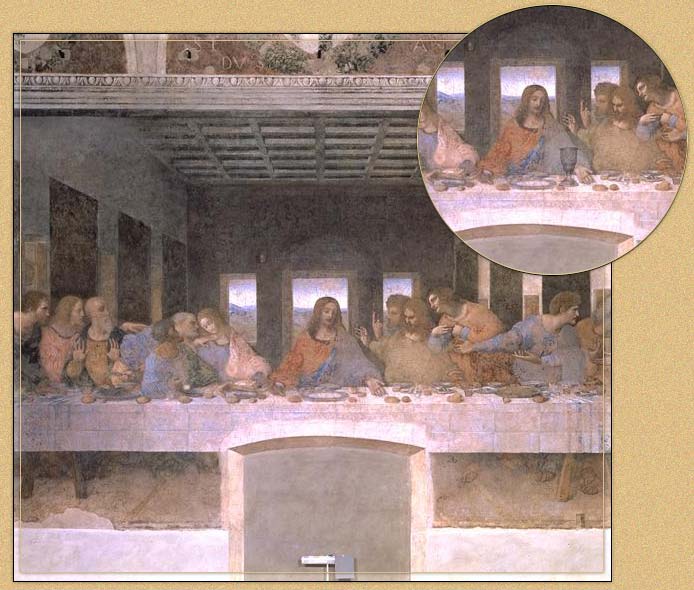 |
||||||||||
 |
 |
|||||||||
|
INTRODUCTION |
||||||||||
 |
||||||||||
|
The method in which the painting was executed, on a dry surface, rather than on wet plaster, the traditional method for a fresco, meant that it stood up very poorly to the test of time. By 1556, the notable contemporary historian of the Renaissance Giorgio Vasari was describing the painting as "ruined", to such a degree that the figures were no longer recognizable. In 1652, a door was cut through the bottom of the painting -- almost completely gone by that time -- and this can be seen in the gray unpainted area immediately below Jesus. The arch was eventually bricked up again. Michelangelo Bellotti was the first artist to try to restore the painting. In 1726, he attempted to paint over the damaged sections with oil paint, and then cover the lot with varnish to preserve it from further deterioration. However, the methods and materials of the time were unequal to the task, and another restoration had to be attempted in 1770, some 44 years later. Giuseppe Mazza completely undid Bellotti's work and started from scratch, essentially re-painting the work. However, he was never allowed to finish, as the public was outraged at what they saw as creative liberties on his part. In 1796, Napoleon's French troops were stationed around the convent and used the refectory as a makeshift prison, though it is unknown what further damage this caused. In 1821, an attempt was made to move the "fresco" to a safer location. Stefano Barezzi, the expert charged with this task, damaged the painting quite badly before he realized that the work was not a fresco, but had been painted on a dry surface. He attempted to fix the damage he had done, but this only made the situation worse. From 1901 to 1908, Luigi Cavenaghi began a careful cleaning of the painting. He was followed by Oreste Silvestri in 1924, who cleaned the painting further and stabilized those parts that were still intact with stucco. In 1943, during World War II, the convent was struck by a bomb. While sandbags had been put up to protect the painting from bomb splinters, vibration may have caused further damage. After the war, from 1951 to 1954, another cleaning and stabilization was attempted by Mauro Pelliccioli. It was not until the end of the 20th Century that a major restoration of this key work of art was undertaken. Between 1978 and 1999, under the leadership of Pinin Brambilla Barcilon, a concerted effort was made to reverse the damage caused by time, dirt, pollution and previous restoration attempts and to permanently stabilize the painting. Since the method used for the original painting made it impossible to move, the refectory was sealed off and set up with climate-controlling equipment. A detailed study of the painting was conducted using state-of-the-art methods such as infrared reflectoscopy and microscopic core-sampling. To determine the painting's original shape, the restorers studied Leonardo's sketches, as well as contemporary copies of the painting.Some areas had undergone such extensive damage that the restorers concluded that they were unrestorable and re-painted these areas in subdued watercolors, in order to demonstrate that these were not part of the originial work. The results of the restoration were unveiled on May 28, 1999. There was considerable controversy over some of the decisions made by the restoration team, which included drastic changes in color, tone, and even the facial features of some of the apostles. The painting today is open for viewing by the general public. |
||||||||||
 |
||||||||||